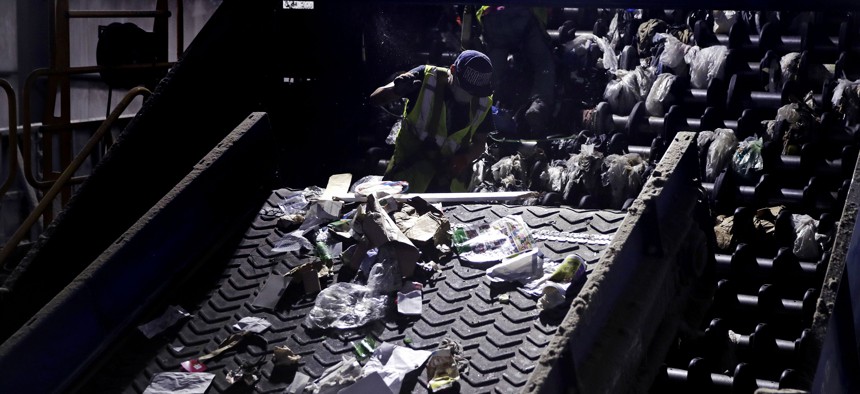Cleaning Up Paper Recycling in South Florida

In this Sept. 6, 2018, photo, workers clean consumer plastic shopping bags from the clogged rollers of a machine which separates paper, plastic and metal recyclable material at EL Harvey & Sons, a waste and recycling company in Westborough, Mass. AP Photo/Charles Krupa
Waste Management reversed its decision to cut mixed paper recycling in 14 Broward County municipalities, but says reduced contamination is needed.
More than one-third of the items the nation’s largest waste-management company collects from recycling bins in Broward County, Florida is actually garbage. That’s compared to about 20% contamination the company, Waste Management, sees nationwide in the recycling stream.
The high contamination rate among recyclables led the company in February to inform 14 municipalities in the county that it planned to stop recycling mixed paper, a category that includes basically all paper products. Local leaders pushed back and Waste Management reversed course saying it would give municipalities more time to improve—but that doesn’t mean they are in the clear.
If municipalities are not able to keep more contaminants—like plastic bags, water hoses and plastic toys—out of the recycling stream, Waste Management plans to send unmarketable mixed paper to incinerators, said Dawn McCormick, a company spokeswoman.
“The existence of a market is crucial to any recycling program,” McCormick said. “The markets for mixed paper are really tight right now. Only really quality material can find a home.”
China used to take about 40% of U.S. paper, plastics, and other recyclables. But since it imposed a strict contamination threshold of .5% and stopped accepting most foreign recyclables, including plastics and paper, local governments have increasingly struggled over what to do with recyclables.
Cities looking to continue recycling paper face two challenges: finding a market and lowering contamination rates.
Mixed paper and cardboard combined account for between 50% to 75% of what Americans put in their recycling bins each year, said Dylan de Thomas, vice president of industry collaboration for The Recycling Partnership.
In the fall of 2017, before China’s policy took effect, mixed paper could be sold for $90 a ton, de Thomas said. Now there is no profit, if not a net loss, to get rid of bales of mixed paper, he said.
But there is some good news on the horizon. The planned expansion or construction of new mills for recycled paper over the next several years will increase the domestic market for mixed paper goods, de Thomas said.
In the meantime, high contamination rates like those cited by Waste Management make it difficult to collect the kind of quality materials that can be made into new products like cardboard boxes or paper grocery store bags. Last year, the company could not sell 400 bales of mixed paper collected from the Broward area because the contamination was so bad, McCormick said.
To continue recycling, rather than incinerating, mixed paper, McCormick said local governments need to better educate residents about what is recyclable and what’s not in order to improve collections.
“We know we’ve confused residents and people wish-cycle,” McCormick said.
The company wants to drive home the message that residents should recycle clean and dry materials, and stick to the basics of paper, cardboard, bottles and cans, she said.
There is work that needs to be done by governments and residents to improve the cleanliness of the materials at the curb, de Thomas said. But some of the onus of improving recycling rates also falls on waste collection companies, which he said should be investing in infrastructure to be able to better sort and collect recyclable materials.
New technologies on the market today, like optical sorters, can improve sorting capacity and help keep contaminants out of mixed paper streams, he said.
“The fees are being paid for by the citizens and the service providers are having to pay to upgrade their equipment,” he said. “If they have to upgrade their truck, they have to go buy a new truck. The community doesn’t have to buy them a new truck.”
Andrea Noble is a staff correspondent with Route Fifty.
NEXT STORY: Local Housing Authorities Give Themselves Perfect Scores. Renters Disagree.





